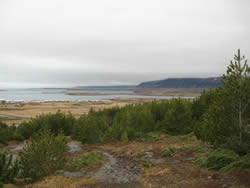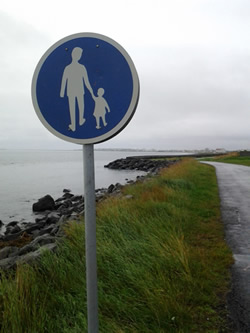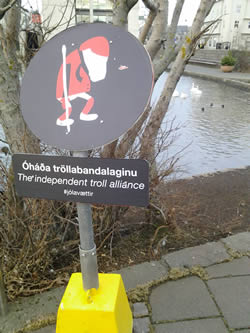- Home » Expat Contests » Writing Contest March 2013 - 5 Things You Can't Find in Iceland...Except When You Can
5 Things You Can't Find in Iceland...Except When You Can
By: Larissa Kyzer
It’s a small country in the middle of the North Atlantic, so one probably expects upon arrival that there are a lot of things that are hard to come by in Iceland. This is certainly true, but nevertheless, Iceland, like Walt Whitman, “contains multitudes” and is awash with seemingly conflicting and incongruous facets and elements. There are a lot of exceptions to the rule here.So here is a list of five things that you can’t find in Iceland...Except when you can.
- Cold Showers
Iceland has no shortage of geothermal energy sources, and the country taps into these “indigenous, renewable resources” for the vast majority of its energy needs. In fact, “almost 90% of Iceland's houses and buildings are heated by natural hot water.” One of the best things about having such an abundance of hot water is that the showers (and dish-washing water) in Iceland are pretty much always hot—scalding, if you’re not careful. Luckily, there are these handy little buttons on the shower temperature gauges which prevent you from accidentally turning the water on at full heat, which is over 50° C (122° F). (Unfortunately, these handy buttons aren’t installed for kitchen sink taps, which means that dish washing can quickly become a rather perilous activity, if the water gets too hot unexpectedly.)
Exception: Many pools around the city have steam rooms and saunas in addition to the (geothermally-heated) pools and hot pots. After sitting in the steam room, you’re required to shower off if you want to hop back in the pool, and often, these showers are outside. In the winter, this can make for a nippy transition. (For you modest Americans out there, don’t worry. You don’t have to do the full monty in the outdoor showers—this’ll just be a bracing rinse-off.) - Vegetarians
I had an Icelandic teacher who quipped that “growing up I had never heard of a vegetarian, but I had heard of cannibals.” Well, times have changed a great deal, but even now, people eat a lot of meat (particularly lamb) in Iceland, and vegetarian meals can take some looking to find, particularly outside of Reykjavík. On a menu in a typical restaurant in the countryside, you’ll often only have a few dishes to choose from: lamb, fish, and maybe, chicken or pork. The “vegetarian option” (for a full entree) is well, not always an option.
Exception: For a city of its size, there are actually a good number of vegetarian restaurants in Reykjavík, and it’s worth noting that you can always find good vegetarian options on the menu in most places, particularly at Indian/Pakistani and Thai restaurants. There are actually a fair number of raw food enthusiasts in Reykjavík, too. The Iceland Express blog posted at least a partial list of vegetarian restaurants in Reykjavík a few years back (although the first place on the list has since closed). For raw food, check out Gló, the very popular restaurant owned by chef Sólveig Eiríksdóttir who was voted “Favourite Raw Gourmet Chef” in 2012. - Trees
There’s a commonly repeated joke here: “What do you do if you get lost in an Icelandic forest? -Stand up!” This garners a chuckle because, firstly, there really are not many trees here, and secondly, they are often rather diminutive. But at the time of Iceland’s settlement (874 - 930), “birch forest and woodland covered 25-40% of Iceland's land area.” What happened? Well, the settlers cleared a lot of forest area for farming and grazing purposes, they used wood for fuel and construction, and charcoal (“an important forest product”) was needed for iron smelting. (I don’t know all this off the top of my head, but if you’re interested, check out “Forestry in a Treeless Land,” an informative essay about just that, written by the division chief of the Icelandic Forest Service, Throstur Eysteinsson.)
Exception: Afforestation has become something of a priority in Iceland: “Since the mid 1990's, state support for farm afforestation has spread to all parts of Iceland and afforestation goals have become variable resulting in increased use of native birch and other species not grown for wood production.” One of these afforestation projects is the Millennium Forests project, which began in 2000. The project was to plant one tree for each Icelander, in small forests created in five locations in the country. At the time, Iceland’s population was 283,000, which makes for a lot of trees. - Strangers
Currently, Iceland’s population is 320,000, but the vast majority of people—over 200,000—live in the capital area. While it would be an exaggeration to say that everyone literally knows everyone, it is fair to say that Six Degrees of Separation is a very, very easy game to play here. Even if you are not Icelandic, and have only just moved to Iceland, you’ll quickly find yourself recognizing a good number of the people you pass on the street. Moreover, the expat community is well-connected through Facebook and other outlets, so even if you haven’t met another expat face-to-face, you may still “know” them (like, in internet terms). This is a rather cozy state of things for the most part, but Iceland is not the place to go if you want to be anonymous.
Exception: Tourism is a very big industry in Iceland, and the country gets a lot of tourists, which always mixes up the city crowd. This is particularly true during the summer months and the annual Iceland Airwaves festival. - Santa Claus
It’s true: Iceland has no Santa Claus...
Exception: Icelanders will sometimes say that they don’t have one Santa, they have thirteen. Or rather, they have 13 jólasveinar, often called “Yule Lads” in English, who show up one by one in the days leading up to Christmas Eve, before they each take their leave again on the 13 nights after. Each night leading up to Christmas, Icelandic children put a shoe on their windowsill so that the arriving lad can leave them a small treat (that is, if they have been good—bad kids are supposed to get a rotten potato instead). While they are at it, the lads create a little mischief, the exact spirit of which can often be discerned from their names, which include:- Þvörusleikir: Spoon-licker
- Hurðaskellir: or Door-slammer
- Gluggagægir: Window-peeper
- Ketkrókur: Meat-hook (this one sounds particularly ominous so to clarify, he’s fond of using said hook to steal lamb roasts)
Although they have gotten in the habit of leaving gifts nowadays, the lads haven’t always been so obliging. In fact, descended from trolls, they were originally used to scare children into good behavior. Their mother, Grýla, is a giantess who was said to come to town in search of naughty children around Christmastime, who she would take home and stew for dinner. (She also has a particularly terrifying Christmas Cat, who eats kids who don’t get a new piece of clothing in time for Christmas.) The stories about Grýla and her sons became so frightening that in 1746, a public decree was issued “prohibiting the use of Grýla and the Yuletide Lads to terrify children.”
Grab a badge that links to this contest entry!
 Copy and paste code to display this Contest Entry Badge:
Copy and paste code to display this Contest Entry Badge:Contest Comments » There are 3 comments

Amanda R. wrote 11
years ago:
I loved this article! I love your title and the quote about vegetarians is hilarious. I also cannot believe the country has only 320,000 people! I live in China where the average city has 7 million people and a small town has 1 million people. You're talking about the population of a village in the whole country. That is just amazing to me. Sounds like a great, laid-back place to visit.

Tiffany Wacaser wrote 11
years ago:
Love this clever twist! I lived in Sweden for several years and knew quite a few Icelanders as they would often study in Lund. It's a place I've always wanted to visit.

Sara Asch wrote 11
years ago:
A fun and enlightening read. And I am impressed that the normal associations about Iceland- no sun light in the winter, no darkness in the summer- was not included! Can't wait to visit Iceland and experience a good hot shower (never enough hot water in Maine in the winter; seems only fair that cold Iceland should have an inexhaustible supply) and some great local lamb.



 Larissa Kyzer is an American expat living in Iceland. Blog description: I moved from Brooklyn, New York to Reykjavík, Iceland to start studying Icelandic as a Second Language at the University of Iceland.
Larissa Kyzer is an American expat living in Iceland. Blog description: I moved from Brooklyn, New York to Reykjavík, Iceland to start studying Icelandic as a Second Language at the University of Iceland.





